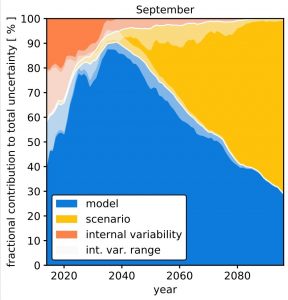Explaining the spread in projections of Arctic sea ice
A pair of studies introduce a simple way of explaining and constraining the spread in projections of Arctic sea ice
Key Points & Overview
- Uncertainties in projections of Arctic sea-ice area arise from a combination of internal variability, model structure, and emission scenario.
- Model structure is the largest source of uncertainty in projections of Arctic-sea ice, with biases in simulating present-day sea ice contributing most to the spread.
- Using a simple model with observational constraints suggests that the Arctic will likely be ice-free in September sometime between 2036 to 2056 under a high-emissions scenario.
The decline in Arctic sea-ice cover is one of the most recognizable symbols of anthropogenic climate change. However, while state-of-the-art climate models simulate a decline of Arctic sea ice area over the 21st century, there are large uncertainties in the estimated rate and magnitude of Arctic sea ice loss. Estimates of a seasonally ice-free Arctic can range from as early as 2030 to as late as 2100.

A recent study¹ led by Dave Bonan, a graduate student at Caltech, along with his colleagues Flavio Lehner, an assistant professor at Cornell University, and Marika Holland, a senior scientist at the National Center for Atmospheric Research, tried to understand where the large variations in climate model projections come from. The team identified three major sources of uncertainty in projections of Arctic sea ice: (1) internal variability, referring to the natural fluctuations in climate, (2) model structure, referring to how climate models are designed, and (3) emission scenario, encapsulating the trajectory of anthropogenic emissions. Out of these three factors, the group found that a dominant source of uncertainty in projections of Arctic sea ice for the first few decades is internal variability of the climate system. However, around mid-century, model uncertainty accounts for the majority of the uncertainty, making up 70-90% of the total uncertainty for projections of September Arctic sea ice area. Model uncertainty is even more pronounced during winter months, where it accounts for around 80% of the total uncertainty throughout the rest of the century.
The large amount of uncertainty due to model structure in projections of Arctic sea ice area over the 21st century makes it desirable to understand the factors that contribute to climate model differences, so they can be further constrained, and uncertainty can be further reduced. Recently, in a separate study², Bonan and his colleagues (Tapio Schneider, a professor at Caltech; Ian Eisenman a professor at Scripps Institution of Oceanography; and Robb Wills, a research scientist at the University of Washington) developed a simple model that accurately emulates the evolution of Arctic sea ice area as simulated by climate models. They then used this simple model to quantify the contributing factors to model uncertainty and found that biases in simulating present day sea ice contribute most to the model uncertainty. Much of the rest of the model uncertainty can be attributed to differences in the amount of Arctic warming simulated by climate models.
Having shown that this simple model accurately emulates the evolution of Arctic sea ice area as simulated by climate models, Bonan and co-authors used observational data to constrain the simple model and improve future Arctic sea ice projections. Using these constraints, the team found that under a high-emissions scenario, it is ‘likely’ (>66% probability) that the Arctic will be ice-free sometime between 2036-2056 for September, which is 10-20 years earlier than climate models suggest. Further, under high emissions they found that an ice-free Arctic in September is ‘very likely’ (>90% probability) between 2045-2065, which is around 50 years earlier than climate models suggest. Similarly, under a medium-emissions scenario, the Arctic is projected to be free of September sea-ice sometime between 2042-2062, around 15 years earlier than suggested by climate models. Notably, under a low-emissions scenario the ice-free Arctic date for September is pushed to around 2091. This trend clearly implies that reducing anthropogenic carbon-dioxide emissions will reduce the chance of seeing ice-free summers in the Arctic.
Continuing to refine and reduce uncertainty in projections of Arctic sea ice will be a crucial step in protecting the Arctic environment. Properly quantifying the timing of an ice-free Arctic helps to improve conservation efforts that protect wildlife that rely on sea ice, like polar bears and walruses.
Citations:
¹Bonan, D. B., Lehner, F., & Holland, M. M. (2021). Partitioning uncertainty in projections of Arctic sea ice. Environmental Research Letters, 16 (4), 044002. https://doi.org/10.1088/1748-9326/abe0ec
², , , & (2021). Constraining the date of a seasonally ice-free Arctic using a simple model. Geophysical Research Letters, 48, e2021GL094309. https://doi.org/10.1029/2021GL094309
Dave Bonan is a graduate of the Department of Atmospheric Sciences and worked as the UW Program on Climate Change Undergraduate Assistant from 2016 to 2019.